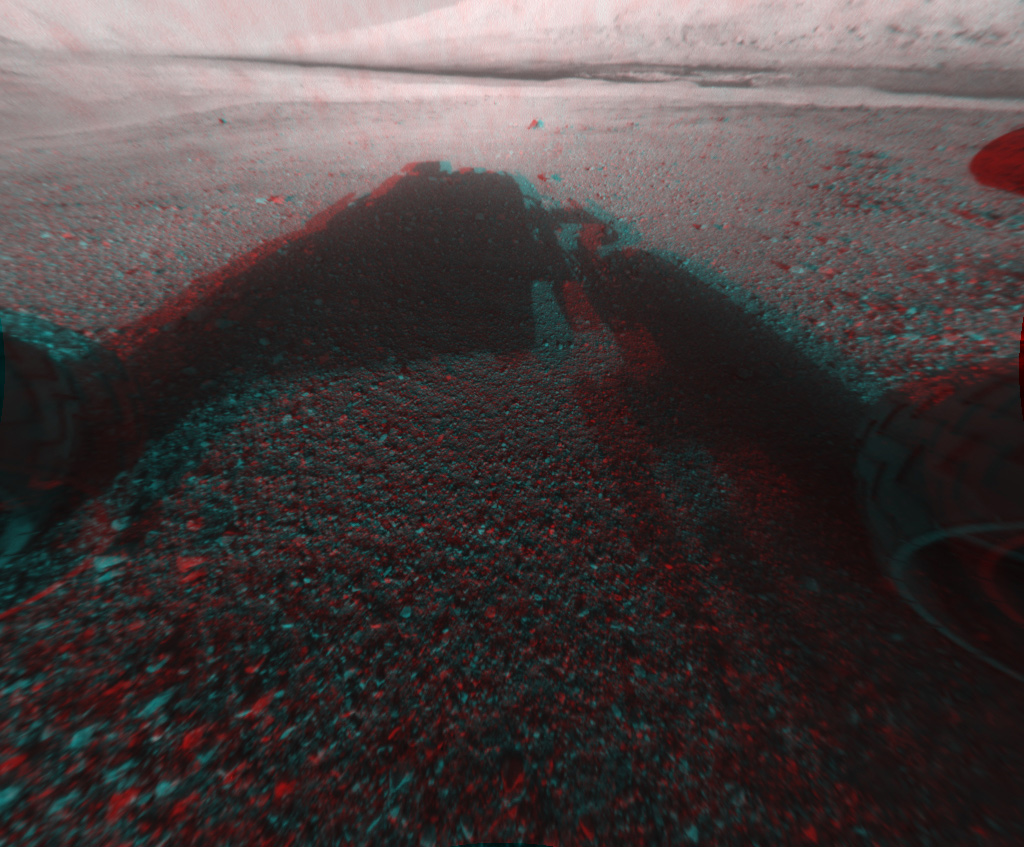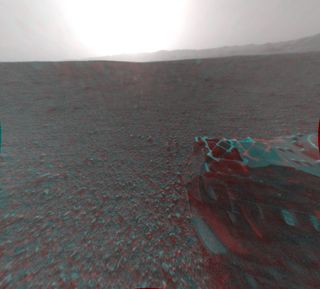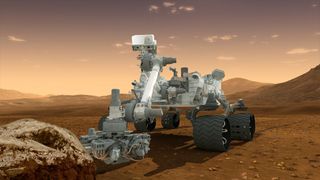New Mars Photos: First 3-D Views From NASA's Curiosity Rover

Break out your 3-D glasses! NASA's new Mars rover has beamed back its first 3-D photos of the Red Planet.
The Mars rover Curiosity snapped the three-dimensional photos by combining images from the robot's navigation cameras, which operate in pairs to provide stereo views of the Martian surface.
In one photo, the cameras provide a rear-view vista that includes the rim of Curiosity's Gale Crater landing site. One of the rover's six big wheels is visible in the image's lower right.
A second 3-D image from the Mars rover offers a forward view that captures Curiosity's long shadow and part of Mount Sharp, a 3.4-mile-high (5.5-kilometer) mountain, in the distance. Scaling the mountain is one of Curiosity's long-term goals, rover mission scientists have said.

The $2.5 billion Curiosity rover landed on Mars late Sunday (Aug. 5 PDT) and carries 17 cameras in total in order to photograph the planet's surface. The cameras used to make the new 3-D images are hazard-avoidance cameras designed to spot obstacles in the rover's path.
For redundancy, Curiosity has two pairs of hazard-avoidance cameras mounted to its front and another two pairs on its rear. They have fish-eye lenses, according to a NASA description. Curiosity also carries a different set of navigation cameras on its mast to help plan drives on Mars.
NASA's Curiosity rover, which is also known as the Mars Science Laboratory, is expected to spend at least two Earth years exploring the 96-mile-wide (155 km) Gale crater. The 1-ton rover is the size of a car and uses a nuclear power source to run its 10 sophisticated instrument suites.
Get the Space.com Newsletter
Breaking space news, the latest updates on rocket launches, skywatching events and more!
Mars rover scientists hope Curiosity will able to determine whether Mars is now, or ever was, capable of supporting microbial life.
Currently, mission scientists are checking Curiosity's systems to make sure the rover is in tip-top shape for its two-year Martian expedition. The mission is managed by NASA's Jet Propulsion Laboratory in Pasadena, Calif.

Visit SPACE.com for complete coverage of NASA's Mars rover mission. You can follow SPACE.com Managing Editor Tariq Malik on Twitter @tariqjmalik and SPACE.com on Twitter @Spacedotcom. We're also on Facebook & Google+.
Join our Space Forums to keep talking space on the latest missions, night sky and more! And if you have a news tip, correction or comment, let us know at: community@space.com.

Tariq is the Editor-in-Chief of Space.com and joined the team in 2001, first as an intern and staff writer, and later as an editor. He covers human spaceflight, exploration and space science, as well as skywatching and entertainment. He became Space.com's Managing Editor in 2009 and Editor-in-Chief in 2019. Before joining Space.com, Tariq was a staff reporter for The Los Angeles Times covering education and city beats in La Habra, Fullerton and Huntington Beach. In October 2022, Tariq received the Harry Kolcum Award for excellence in space reporting from the National Space Club Florida Committee. He is also an Eagle Scout (yes, he has the Space Exploration merit badge) and went to Space Camp four times as a kid and a fifth time as an adult. He has journalism degrees from the University of Southern California and New York University. You can find Tariq at Space.com and as the co-host to the This Week In Space podcast with space historian Rod Pyle on the TWiT network. To see his latest project, you can follow Tariq on Twitter @tariqjmalik.










